|
|
|
|
|
|
When Milwaukee transit fans refer to The Milwaukee Electric Railway & Light Co., they usually use the abbreviated initials TM,
and they usually include TMER&L and its subsidiaries and successors.... Milwaukee Light, Heat & Traction (MLH&T),
The Milwaukee Electric Railway & Transport Co. (TMER&T), Wisconsin Motor Bus Lines (WMBL) and The Milwaukee & Suburban
Transport Co. (M&ST)
The Milwaukee Electric Railway & Light Co. was the largest electric railway and electric utility system in Wisconsin. It combined
several of the earlier horsecar, steam dummy and streetcars lines into one system. It's Milwaukee streetcar lines soon ran on most major
streets and served most areas of the city. Its interurban lines reached throughout southeastern Wisconsin. They also operated the
streetcar lines in Appleton, Kenosha and Racine as well as doing their own switching operations at the Port Washington and Lakeside
power plants.
TM operated its own shops, which could repair, rebuild or build complete streetcars, interurbans and freight locos. They also
designed many innovations, such as an articulated three-truck train.
The first electric streetcar in Milwaukee operated on Wells Street April 3, 1890. The last streetcar in Milwaukee (and Wisconsin)
operated on Wells Street on March 2, 1958.
The first interurban ran between Milwaukee and Kenosha on June 1, 1897. Other lines soon reached out to Watertown, Burlington
and East Troy. In 1922 TM acquired the Milwaukee Northern Railway and added their Milwaukee to Sheboygan interurban line to the
system.
During the depression, streetcar and interurban lines began to be cut back, replaced with buses, abandoned or sold. Abandonments
ceased during WWII, when gas and tires were rationed, and defense workers needed transportation. After the war, riders returned to
their autos and abandonments resumed. The last two remnants of interurban lines were to Hales Corners and Waukesha. They closed
out their days being operated in Rapid Transit service by Speedrail until June 30, 1951. Electric locos continued operating at the power
plants until the early 1970's.
A complete history, or even a comprehensive list of historical highlights would be too involved for the purpose of this website. If
you are interested in more details, the are several fine books listed on our "Resources" page.
|
|
|
|
This map shows the TM interurban system after 1922 when the Milwaukee
Northern Line was added from Milwaukee to Sheboygan.
Plans for the Watertown line to reach Madison, the East Troy line to reach
Delevan and Elkhorn, and the Burlington line to reach Lake Geneva were
never fulfilled.
|
|
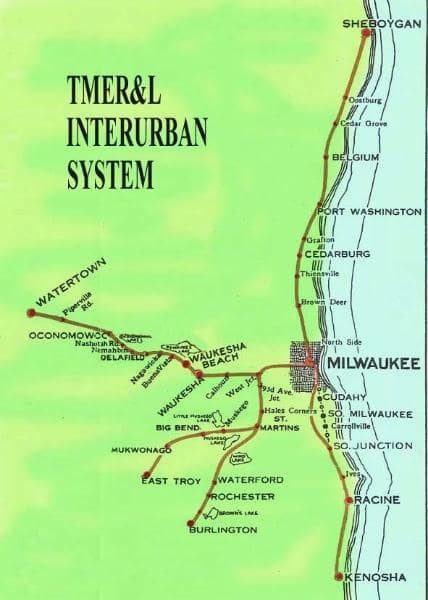 |
|
|
|
|
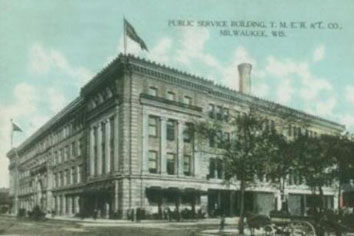 |
|
Built in 1905, the Public
Service Building takes up
the block bounded by 2nd,
3rd, Michigan and
Everett. It contained the
corporate offices as well as
interurban terminal. The
building has been restored
to earlier appearance,
including large facsimile
doors where the
interurbans entered. It
remains in use by WE
Energies, and is a
Wisconsin Historical
Landmark.
Emblems above the main
door reflect its heritage.
|
|
|
|
|
|
|
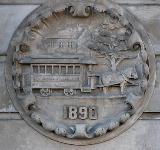 |
|
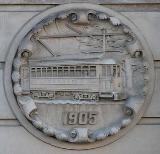 |
|
|
|
|
|
|
|
|
|
|
|
|
|
|
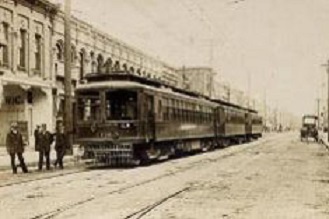 |
|
 |
|
|
|
Left: Early TMER&L interurbans were
built with the unique two front windows as
shown in this posed photo in Watertown.
Right: TM's shops rebuilt them into the
more traditional style as seen in this photo
in Waukesha.
|
|
|
|
|
|
|
|
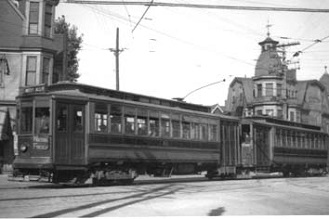 |
|
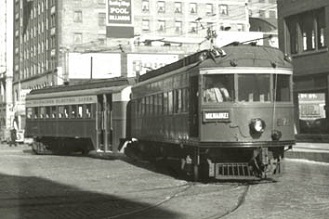 |
|
|
|
Left: TM pioneered the concept of an
articulated two-car three-truck train, first
using older streetcars, as seen on Fond Du
Lac Ave. crossing Center Street.
Right: A duplex interurban about to enter
the Public Service Building from 2nd Street.
|
|
|
|
|
|
|
|
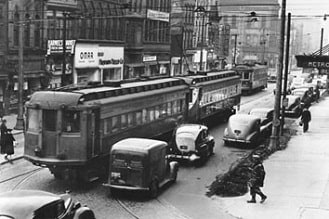 |
|
In the beginning of interurban operation,
they accessed downtown via streetcar lines,
mingling with the streetcars, vehicles and
pedestrians.
Left: Interubans and streetcars on a busy
3rd Street.
Right: Interuban and streetcar on crowded
Clybourn Street.
|
|
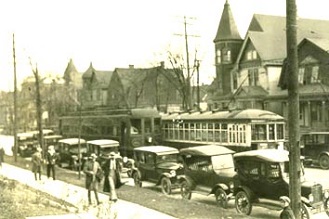 |
|
|
|
|
|
To eliminate some of the problems, TM began to construct a Rapid Transit line. The first, was for the lines to Watertown, East Troy and
Burlington. They already had some private-right-of way from the east edge of Calvary Cemetery west to Hawley Road which included
this station (below) for the Cemetery and the National Soldiers Home.
|
|
|
|
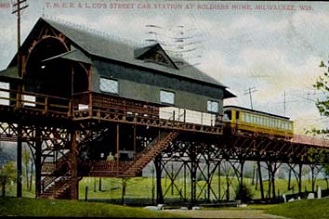 |
|
Right: After the station was removed, the
ground was leveled. An east bound
interurban at what became known as
Cemetery Curve.
The line was then extended west to 92nd,
where it began a curve south to join up
with the previous lines. The Route 10
streetcar line joined the Rapid Transit line
from the right. This right-of-way and the
retaining wall still exist
|
|
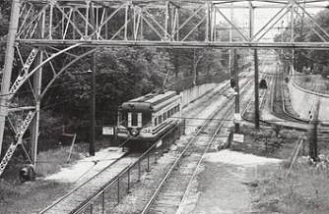 |
|
|
|
|
|
|
|
|
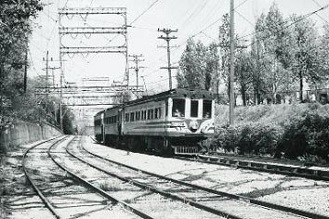 |
|
Left: A single car leads a duplex unit in the
cut between Calvary and the Veterans
Cemeteries.
Right: A Rt. 10 800 series streetcar rolls
along the private right-of-way near Hawley
Road on the West Allis branch.
Space along the left had been occupied by
Rapid Transit tracks.
|
|
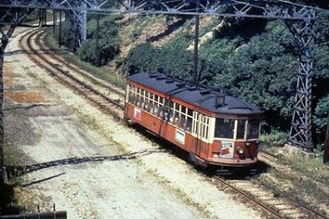 |
|
|
|
|
|
|
Most ambitious and expensive part of the Rapid Transit Line was construction from the Cemetery Curve east to 8th Street. It included a
bridge over the Menomonee Valley, cut and fill, removal of buildings and building bridges for streets to pass over, a short section of
elevated over Hibernia Street and the beginning of a subway, that was to start at 8th Street and end under the Public Service Building.
|
|
|
|
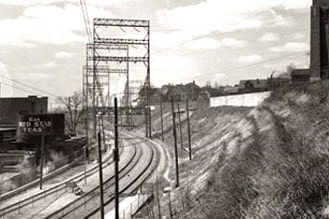 |
|
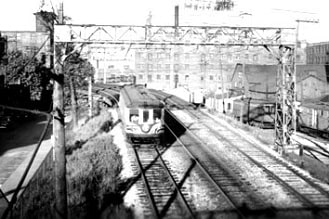 |
|
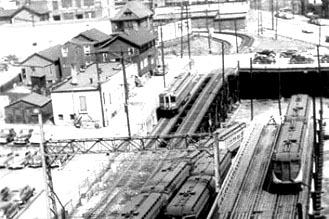 |
|
|
|
Above Left: Right of way looking west from 27th Street viaduct. Middle: Looking east towards elevated over Hibernia Street.
Above Right: Looking east at the subway entrance under 8th Street. Due to the Depression, the construction only went about one block
before the project was cancelled. Trains accessed street trackage to the Public Service Building via a "temporary" ramp. Most of this
right-of-way is now occupied by the I-94 freeway and the Marquette Interchange.
|
|
|
|
 |
|
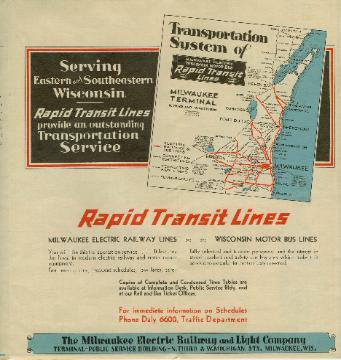 |
|
 |
|
 |
|
|
|
|
|
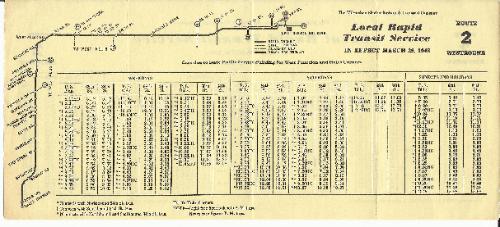 |
|
|
|
|
|
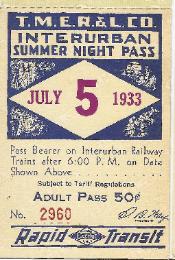 |
|
|
|
|
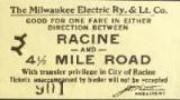 |
|
|
|
|
|
|
|
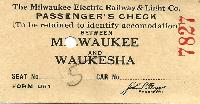 |
|
|
|
|
|
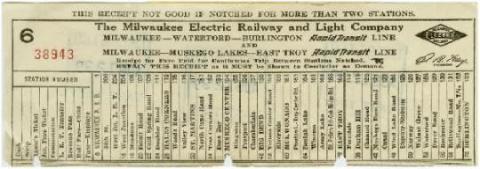 |
|
|
|
|
|
|
|
|
|
|
Images of TMER&L interurbans in the cities they served
can be found on "Wisconsin Trolley Photos Pages".
Click the link below to view TMER&L Streetcars.
|
|
|
|
|
|
 |
|
|
|
|